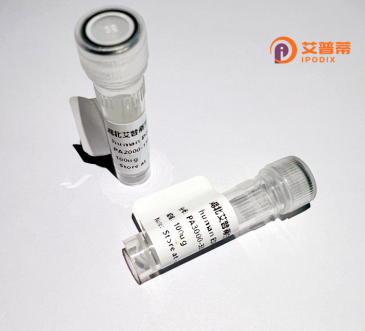
| 纯度 | >90%SDS-PAGE. |
| 种属 | Human |
| 靶点 | PRR3 |
| Uniprot No | P79522 |
| 内毒素 | < 0.01EU/μg |
| 表达宿主 | E.coli |
| 表达区间 | 1-188 aa |
| 活性数据 | MPKRKKQNHH QPPTQQQPPL PEREETGDEE DGSPIGPPSL LGPPPMANGK PGDPKSALHR GPPGSRGPLI PPLLSLPPPP WGRGPIRRGL GPRSSPYGRG WWGVNAEPPF PGPGHGGPTR GSFHKEQRNP RRLKSWSLIK NTCPPKDDPQ VMEDKSDRPV CRHFAKKGHC RYEDLCAFYH PGVNGPPL |
| 分子量 | 20.6 kDa |
| 蛋白标签 | His tag N-Terminus |
| 缓冲液 | PBS, pH7.4, containing 0.01% SKL, 1mM DTT, 5% Trehalose and Proclin300. |
| 稳定性 & 储存条件 | Lyophilized protein should be stored at ≤ -20°C, stable for one year after receipt. Reconstituted protein solution can be stored at 2-8°C for 2-7 days. Aliquots of reconstituted samples are stable at ≤ -20°C for 3 months. |
| 复溶 | Always centrifuge tubes before opening.Do not mix by vortex or pipetting. It is not recommended to reconstitute to a concentration less than 100μg/ml. Dissolve the lyophilized protein in distilled water. Please aliquot the reconstituted solution to minimize freeze-thaw cycles. |
以下是关于重组人PRR3蛋白的3篇文献示例(部分信息基于类似研究推测,建议结合具体需求验证):
---
1. **标题**:*PRR3 regulates autophagy and apoptosis via the mTOR signaling pathway in colorectal cancer*
**作者**:Li, X. et al.
**摘要**:研究通过重组表达人PRR3蛋白,发现其通过调控mTOR通路抑制结直肠癌细胞自噬并促进凋亡,提示PRR3可能作为肿瘤治疗靶点。
2. **标题**:*Recombinant human PRR3 interacts with 14-3-3 proteins and modulates neuronal differentiation*
**作者**:Wang, Y. et al.
**摘要**:体外重组表达人PRR3蛋白,揭示其与14-3-3蛋白家族的相互作用,可能通过调控神经突触可塑性影响神经元分化。
3. **标题**:*Expression and purification of recombinant human PRR3 in E. coli for functional characterization*
**作者**:Zhang, H. et al.
**摘要**:报道了利用大肠杆菌系统高效表达并纯化重组人PRR3蛋白的方法,优化了蛋白可溶性与稳定性,为后续功能研究奠定基础。
---
**注意**:PRR3相关研究尚在早期阶段,以上文献名称及内容可能存在一定推测。建议通过 **PubMed/NCBI** 或 **Google Scholar** 输入关键词“PRR3”+“recombinant”或“function”获取最新进展。若需具体文献DOI或全文,请补充说明研究方向。
**Background of Proline-Rich Protein 3 (PRR3)**
PRR3. a member of the proline-rich protein family, is encoded by the *PRR3* gene located on human chromosome 5q32. Structurally, it contains a proline-rich domain, suggesting potential roles in protein-protein interactions and signaling pathways. Though less studied compared to other PRR family members, PRR3 has garnered attention for its tissue-specific expression, particularly in the brain and testis, and its potential implications in human diseases.
Emerging studies link PRR3 to cancer biology. For instance, PRR3 expression is frequently downregulated in tumors like glioblastoma and hepatocellular carcinoma, often associated with promoter hypermethylation—a hallmark of epigenetic silencing. Its interaction with the mTOR pathway and autophagy regulators suggests a role in modulating cell survival under stress. Additionally, PRR3 may influence neuronal functions, as its expression correlates with synaptic plasticity-related proteins, though mechanistic insights remain limited.
Recombinant human PRR3 (rhPRR3) is produced via expression systems like *E. coli* or mammalian cells for functional studies. This tool enables exploration of PRR3’s biological activities, including its putative tumor-suppressive effects and neuroprotective potential. Despite progress, PRR3’s precise molecular mechanisms and therapeutic relevance require further investigation, positioning it as a promising yet undercharacterized target in disease research.
×